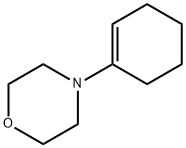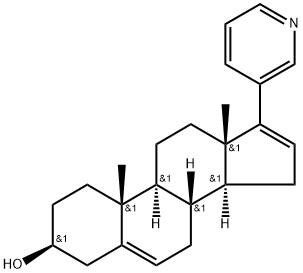N-(1-Cyclohexen-1-yl)morpholine
Synonym(s):4-(1-Cyclohexen-1-yl)morpholine
- CAS NO.:670-80-4
- Empirical Formula: C10H17NO
- Molecular Weight: 167.25
- MDL number: MFCD00006163
- EINECS: 211-579-6
- SAFETY DATA SHEET (SDS)
- Update Date: 2025-07-24 18:13:50

What is N-(1-Cyclohexen-1-yl)morpholine?
Description
1-Morpholinocyclohexene (N-(1-Cyclohexen-1-yl)morpholine) falls under the category of organic compounds called morpholine class of heterocyclic amines. This colorless liquid possesses a distinct amine-like odor and displays remarkable versatility with widespread applications in multiple industries, including agrochemicals and cosmetics. Moreover, it is a valuable solvent, corrosion inhibitor, and integral component in lubricants[1].
Chemical properties
CLEAR COLOURLESS TO LIGHT YELLOW LIQUID
Synthesis Reference(s)
Synthesis, p. 529, 1984 DOI: 10.1055/s-1984-30893
References
[1] R. Nesi. “Reactions of 3,5-dimethyl-4-nitroisoxazole with cyclic enamines and 1-diethylaminopropyne.” Heterocycles 32 1 (1991): 1913–1921.
Properties of N-(1-Cyclohexen-1-yl)morpholine
| Boiling point: | 118-120 °C10 mm Hg(lit.) |
| Density | 0.995 g/mL at 25 °C(lit.) |
| refractive index | n |
| Flash point: | 155 °F |
| storage temp. | 2-8°C |
| form | clear liquid |
| pka | 6.33±0.20(Predicted) |
| color | Colorless to Light yellow to Light orange |
| BRN | 118696 |
| InChI | InChI=1S/C10H17NO/c1-2-4-10(5-3-1)11-6-8-12-9-7-11/h4H,1-3,5-9H2 |
| CAS DataBase Reference | 670-80-4(CAS DataBase Reference) |
| NIST Chemistry Reference | Morpholine, 4-(1-cyclohexen-1-yl)-(670-80-4) |
| EPA Substance Registry System | Morpholine, 4-(1-cyclohexen-1-yl)- (670-80-4) |
Safety information for N-(1-Cyclohexen-1-yl)morpholine
| Signal word | Warning |
| Pictogram(s) |
 Exclamation Mark Irritant GHS07 |
| GHS Hazard Statements |
H315:Skin corrosion/irritation H319:Serious eye damage/eye irritation H335:Specific target organ toxicity, single exposure;Respiratory tract irritation |
| Precautionary Statement Codes |
P261:Avoid breathing dust/fume/gas/mist/vapours/spray. P305+P351+P338:IF IN EYES: Rinse cautiously with water for several minutes. Remove contact lenses, if present and easy to do. Continuerinsing. |
Computed Descriptors for N-(1-Cyclohexen-1-yl)morpholine
| InChIKey | IIQFBBQJYPGOHJ-UHFFFAOYSA-N |
| SMILES | N1(C2CCCCC=2)CCOCC1 |
New Products
Indole Methyl Resin tert-butyl 9-methoxy-3-azaspiro[5.5]undecane-3-carboxylate Boc-His(Boc)-OH 2-CTC Resin 4-Chloro-7-tosy1-7Hpyrrolo[2,3-d]pyrimidine 5,7-Dibromo-1H-indole 2,5-dichloro-N-hydroxy-4,6-dimethylpyridine-3-carboximidamide 2,2-Dimethoxy-7-azaspiro[3.5]nonane hydrochloride 4-chloromethyl-5-methyl-1,3-dioxol-2-one (DMDO-Cl) R-2-BENZYLOXY PROPIONIC ACID 1,1’-CARBONYLDIIMIDAZOLE 1,1’-CARBONYLDI (1,2-4 TRIAZOLE) N-METHYL INDAZOLE-3-CARBOXYLIC ACID 4-((2-hydroxyethyl)thio)benzoic acid 1-(TERT-BUTOXYCARBONYL)-2-PYRROLIDINONE Methyl 6-methylnicotinate 3-Pyridineacrylic acid tert-Butyl carbazate TETRAHYDRO-2H-PYRAN-3-OL 2-((4-morpholinophenylamino) (methylthio) methylene) malononitrile 3-(4-morpholinophenylamino)-5-amino-1H-pyrazole-4-carbonitrile 2,4-dihydroxybenzaldehyde 1,3-Diethyl-1,3-Diphenylurea Methyl 2-methylquinoline-6-carboxylateRelated products of tetrahydrofuran





![CarbaMic acid, [(2R)-2-(2,2-diMethyl-4H-1,3-benzodioxin-6-yl)-2-hydroxyethyl]-, 1,1-diMethylethyl ester](https://img.chemicalbook.in/CAS/20150408/GIF/452339-72-9.gif)
![CarbaMic acid, [2-(2,2-diMethyl-4H-1,3-benzodioxin-6-yl)-2-oxoethyl]-, 1,1-diMethylethyl ester](https://img.chemicalbook.in/CAS/20150408/GIF/452339-71-8.gif)

You may like
-
 670-80-4 1-MORPHOLINO-1-CYCLOHEXENE 98%View Details
670-80-4 1-MORPHOLINO-1-CYCLOHEXENE 98%View Details
670-80-4 -
 1-Morpholino-1-cyclohexene CAS 670-80-4View Details
1-Morpholino-1-cyclohexene CAS 670-80-4View Details
670-80-4 -
 N-Morpholino-1-cyclohexene 97.00% CAS 670-80-4View Details
N-Morpholino-1-cyclohexene 97.00% CAS 670-80-4View Details
670-80-4 -
 Pyridine 99.5% HPLC /UV SpectroscopyView Details
Pyridine 99.5% HPLC /UV SpectroscopyView Details
110-86-1 -
 Piperazine Spot supply, best priceView Details
Piperazine Spot supply, best priceView Details
110-85-0 -
 Dibutyl PhthalateView Details
Dibutyl PhthalateView Details
84-74-2 -
 Imidazole Spot supply, competitive priceView Details
Imidazole Spot supply, competitive priceView Details
288-32-4 -
 Thiourea 99% ARView Details
Thiourea 99% ARView Details
62-56-6
Statement: All products displayed on this website are only used for non medical purposes such as industrial applications or scientific research, and cannot be used for clinical diagnosis or treatment of humans or animals. They are not medicinal or edible.
